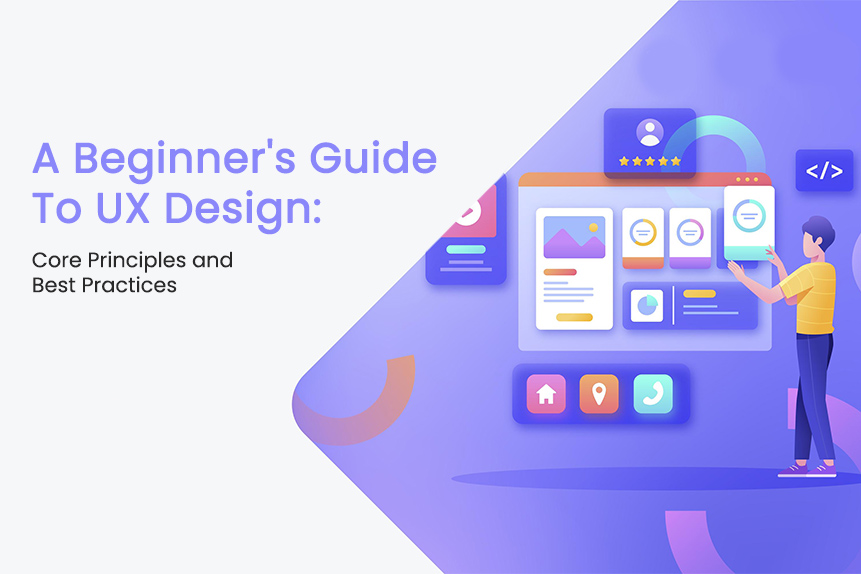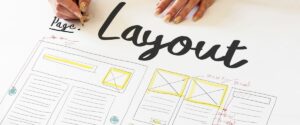
A Beginner’s Guide to UX Design: Core Principles and Best Practices
User experience (UX) design is focused on creating products and services that provide meaningful and relevant experiences to users. The goal of UX design is to make the user’s interaction as smooth, efficient, and enjoyable as possible.
With the rise of digital products and services, UX design has become critical for businesses to succeed and differentiate themselves.
A well-designed UX leads to better customer satisfaction, increased conversion rates, improved user retention and loyalty. On the other hand, a poor UX can destroy a product’s reputation and cause users to switch to competitors.
That’s why UX design skills are highly sought after these days. But for beginners, knowing where to start can be intimidating.
Navigating the Foundations of User Experience Design for Beginners

In this blog, We’ll cover the core principles and best practices that are essential to UX design. We’ll explain the key concepts you need to understand, walk through the typical UX design workflow, and share tips to create user-centric designs.
Whether you’re looking to become a UX designer or want to incorporate UX principles into your existing role, this beginner’s guide will help you get started on the right foot.
By the end, you’ll have a solid foundation to continue building your UX skills and make sure your designs always put users first. Let’s get started!
Core Principles of UX Design

Focus on the user
The most fundamental principle of UX is to always focus on the users. To design an effective experience, you must have a deep understanding of who your users are, what their needs and pain points are, and how they behave.
Conduct user research through methods like interviews, surveys, site analytics, and observation sessions.
Develop user personas that reflect your key audience segments. Identify scenarios and use cases to understand how users interact with your product.
User testing is crucial to gain insights into usability issues and improvement areas. Keep the user at the centre of every design decision.
Simplicity
Strive to create straightforward, intuitive user flows that are easy to navigate. Avoid unnecessary complexities in your information architecture, navigation design, and interactions.
Offer clear concise content that serves the user’s needs. Remove frictions and pain points that create obstacles for users. Efficiency and ease-of-use will make the experience seamless.
Feedback
Provide clear feedback to inform users about what is happening in the system. Indicate when processes are loading or if there are errors.
Confirm when user actions are complete. Feedback cultivates trust in the system and reduces confusion. Progressive disclosure and next steps guide the user along.
Consistency
Maintain visual, UI, interaction, and communication consistency across platforms, screen sizes, and devices.
Adhere to industry wide conventions that users are familiar with. Consistency builds predictability and supports usability.
Accessibility
Ensure your design is inclusive and accessible to users with disabilities. Support compliance with ADA, WCAG standards.
Allow keyboard navigation and screen reader capability. Choose colours and contrast for low vision users. Write ALT text for images. Designing for accessibility improves experience for all.
Best Practices for UX Design

User Research
Conduct user research early in the design process to gain insights into your target users’ needs, behaviours, and motivations.
Useful methods include user interviews, surveys, site analytics review, and observation. Synthesise your findings into representative user personas and profiles. Testing concepts and prototypes with actual users is invaluable.
Information Architecture
Organise content and functionality in an intuitive way that aligns with user expectations. Group related content and tasks.
Structure workflows from high-level tasks down to step-by-step details. Categorise information based on user mental models. Ensure architecture allows for scalability.
Wireframing and Prototyping
Build low-fidelity wireframes focused on content, layout, hierarchy, and flow. Wireframes allow you to iterate and test concepts quickly.
Use prototypes to simulate actual user experiences for evaluation. Prototypes can range from static click-throughs to fully interactive versions.
Visual Design
Apply visual design principles to make sure designs are aesthetically pleasing and on-brand. Use colour, typography, and imagery appropriately for the product and users.
Ensure visuals adhere to usability best practices. Conduct design testing to refine look, feel, and appeal.
Usability Testing
Validate designs with real users early and often. Observe users interacting with prototypes to uncover usability issues and improvement opportunities.
Record sessions for review. Iteratively test and refine the experience based on feedback.
Iterative Design
Good UX evolves incrementally through cycles of testing and refinement. Be prepared to iterate as you learn more about users and from their feedback.
Maintain flexibility to pivot based on insights rather than get locked into initial concepts.
Conclusion
To recap, in this beginner’s guide we covered the fundamental principles and best practices that are key to UX design.
The core principles include: focusing on user needs through research and testing, simplicity in design, clear feedback to the user, consistency across platforms, and accessibility.
We also discussed important best practices like: conducting user research, developing intuitive information architecture, wireframing and prototyping concepts, applying strong visual design, iteratively testing for usability, and using feedback to refine the design.
If you’re new to UX, keeping these principles and best practices in mind will help you create great user experiences. This just scratches the surface of the comprehensive UX design process.
For further learning, We recommend taking a structured UX course, reading seminal books like Don’t Make Me Think and The Design of Everyday Things, and reviewing UX guidelines from leading companies.
We hope this beginner’s guide provided a solid introduction to UX. Please feel free to reach out if you have any other questions as you get started with UX design. We’ll always be happy to help explain concepts or point you toward resources.
The most important thing is to jump right in – start building your UX skills through practice projects and collaborating with experienced designers who can mentor you. With consistent application of UX principles, your abilities will grow exponentially.
FAQs
Are UX Designers in Demand?
Yes, UX designers are in high demand, especially with the increasing importance of user experience in digital products and services. Many companies prioritise UX design to enhance customer satisfaction and stay competitive.
Is UX Design a Good Career?
Yes, UX design is considered a rewarding and promising career. It offers opportunities for creativity, problem-solving, and the chance to positively impact how users interact with technology. The demand for UX designers and their skills contributes to the attractiveness of this career path.
Can UX Design Be Replaced by AI?
While AI can assist in certain aspects of UX design, it is unlikely to fully replace human UX designers. Human creativity, empathy, and understanding of nuanced user needs are integral to the field. AI can be a valuable tool, but the human element remains crucial.
How Do UX Designers Work?
UX designers work by understanding user needs through research, creating intuitive and user-friendly designs, and testing and iterating on their designs based on user feedback. They collaborate with cross-functional teams, including developers and product managers, to ensure a cohesive and effective user experience.
What Do UX Designers Do?
UX designers are responsible for creating seamless and enjoyable user experiences. They conduct user research, design wireframes and prototypes, work on information architecture, apply visual design principles, and perform usability testing. Their goal is to prioritise user needs and enhance overall satisfaction.
What’s User Experience Design?
User Experience Design (UX design) focuses on creating products and services that offer meaningful and positive experiences for users. It encompasses various disciplines, including research, design, and testing, with the ultimate goal of making interactions with a product as smooth and enjoyable as possible.
How to UX Design an App?
Designing a UX-friendly app involves understanding the target users, conducting research, creating user personas, wireframing and prototyping, applying visual design principles, and conducting usability testing. The process includes iterative steps to refine the app based on user feedback.
What Does UX Design Mean?
UX design, short for User Experience design, refers to the process of enhancing user satisfaction by improving the usability, accessibility, and overall delight in the interaction with a product or service. It involves understanding user needs, creating intuitive designs, and continually refining the user experience based on feedback.
Your point of view caught my eye and was very interesting. Thanks. I have a question for you.
I like this web blog it’s a master piece! Glad I found this ohttps://69v.topn google.Expand blog
Can you be more specific about the content of your article? After reading it, I still have some doubts. Hope you can help me.